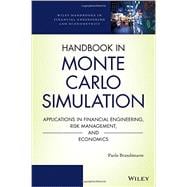An accessible treatment of Monte Carlo methods, techniques, and applications in the field of finance and economics
Providing readers with an in-depth and comprehensive guide, the Handbook in Monte Carlo Simulation: Applications in Financial Engineering, Risk Management, and Economics presents a timely account of the applicationsof Monte Carlo methods in financial engineering and economics. Written by an international leading expert in thefield, the handbook illustrates the challenges confronting present-day financial practitioners and provides various applicationsof Monte Carlo techniques to answer these issues. The book is organized into five parts: introduction andmotivation; input analysis, modeling, and estimation; random variate and sample path generation; output analysisand variance reduction; and applications ranging from option pricing and risk management to optimization.
The Handbook in Monte Carlo Simulation features:
- An introductory section for basic material on stochastic modeling and estimation aimed at readers who may need a summary or review of the essentials
- Carefully crafted examples in order to spot potential pitfalls and drawbacks of each approach
- An accessible treatment of advanced topics such as low-discrepancy sequences, stochastic optimization, dynamic programming, risk measures, and Markov chain Monte Carlo methods
- Numerous pieces of R code used to illustrate fundamental ideas in concrete terms and encourage experimentation
The Handbook in Monte Carlo Simulation: Applications in Financial Engineering, Risk Management, and Economics is a complete reference for practitioners in the fields of finance, business, applied statistics, econometrics, and engineering, as well as a supplement for MBA and graduate-level courses on Monte Carlo methods and simulation.









